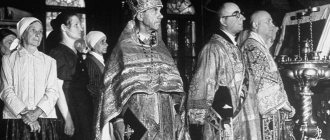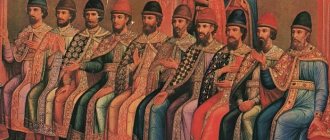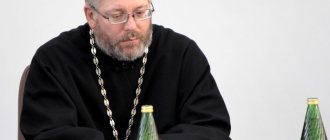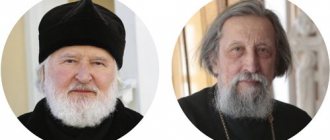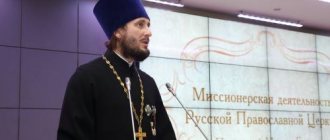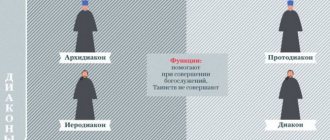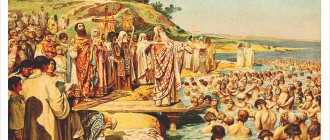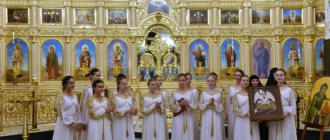During February 2 and 3 of this year, the next Bishops' Council of the Russian Orthodox Church was held in Moscow. It was an important event in the religious life of the country. But before dwelling on the issues that were subject to its consideration, it makes sense to clarify what this body of church authority is and what its history is.
Successors of the Holy Apostles
The practice of convening church councils dates back to New Testament times, when in the year 49 (according to other sources in 51) a council was held in Jerusalem, at which the apostles discussed the most important question - whether circumcision is necessary for acquiring eternal life. It was there that a decree was made freeing all those who were baptized from the need to fulfill most of the Jewish laws and the ritual rituals prescribed by them.
In subsequent years, church councils became a common practice and were convened regularly. At the same time, they were divided into two categories - Local, that is, held within the framework of one local church, and Ecumenical, the very name of which indicates that representatives of churches throughout the Christian world took part in it.
Features of Local Councils
The councils of past times are included in the history of the church mainly by the names of the cities in which they were held, the local churches that became their organizers, the states on whose territory they were convened, as well as the religious denominations that resolved their issues at them.
Representatives of not only a wide range of clergy took part in the work of Local Councils - from bishops to clergy of the lower levels, but also deputations of laity living in these territories. They discussed various issues related not only to doctrine, but also to the structure of church life, as well as to its management.
Compound
Many bishops were transported to the Council by military aircraft. Almost all of them were confessors who went through prisons, camps and exile; Archbishop John of Sarapul and Bishop Alexander of Molotov were released shortly before the Council. As a result, 19 bishops took part in the actions of the Council - all who at that time were in cathedras in territories not occupied by German troops:
- Sergius (Stragorodsky), locum tenens of the patriarchal throne, Metropolitan. Moscow
- Alexy (Simansky), Metropolitan. Leningradsky
- Nikolai (Yarushevich), Metropolitan. Kyiv
- Schisp. Luke (Voino-Yasenetsky), Archbishop. Krasnoyarsk
- John (Bratolyubov), archbishop. Sarapulsky
- Andrey (Komarov), archbishop. Kazansky
- Alexy (Palitsyn), archbishop. Kuibyshevsky
- Stefan (Protsenko), archbishop. Ufa
- Sergius (Grishin), archbishop. Gorkovsky
- John (Sokolov), archbishop. Yaroslavsky
- Alexy (Sergeev), archbishop. Ryazansky
- Vasily (Ratmirov), archbishop. Kalininsky
- Bartholomew (Gorodtsov), Archbishop. Novosibirsk
- Gregory (Chukov), archbishop. Saratovsky
- Alexander (Tolstopyatov), bishop. Molotovsky
- Pitirim (Sviridov), bishop. Kursk
- Veniamin (Tikhonitsky), bishop. Kirovsky
- Dimitri (Gradusov), bishop. Ulyanovsky
- Eleutherius (Vorontsov), bishop. Rostovsky
| September 8, 1943. At the Council of Bishops. |
High clergy forums
In contrast, the participants in the Council of Bishops are exclusively bishops convened to make decisions on the most important internal church issues. It is important to note that the division of church councils into Local and Bishops' councils was established only during the synodal period. Previously, all major decisions related to the life of the church were made individually by its primate.
Nowadays, the Council of Bishops is the highest governing body of both the Russian Orthodox Church and the Ukrainian Church, which is part of the Moscow Patriarchate. Its status was determined by the decisions of the Local Council held in 1945. At the same time, a term appeared that became its designation.
Previous Council of Archpastors
The meeting of archpastors, held in February of this year in Moscow, was preceded by only one council (the Bishops' Council), held in 1961 in the Trinity-Sergius Lavra. An interesting detail is that none of its participants were warned in advance that they would participate in such a representative forum. Everyone then received only invitations to celebrate the memory of its founder and upon arrival they learned about the true purpose of the call. This Council (of Bishops) in 1961 took place at the height of Khrushchev’s anti-religious campaign, and such secrecy was by no means unnecessary.
Recently completed cathedral
So, the current Council of Bishops of the Russian Orthodox Church is the second in a row. Its beginning was preceded by the Divine Liturgy in the Cathedral of Christ the Savior, performed by Archpriest Mikhail (Ryazantsev). Together with Patriarch Kirill, all the delegates who arrived at this largest church forum in recent years from all over the country and from abroad took part in it.
As can be seen from his published documents, as well as from the speeches of the participants in the press conference organized after the completion of the work, the main issue was preparation for the Pan-Orthodox (Ecumenical) Council scheduled for the near future, the venue of which was to be the island of Crete.
About the royal remains
Having familiarized themselves with the results of the work of the commission to study the “Ekaterinburg remains”, the members of the Council expressed satisfaction that the state authorities had decided to conduct a comprehensive examination of these remains and a comprehensive study of the circumstances of the murder of the Royal Family. Currently, the Investigative Committee of the Russian Federation has resumed the investigation into the circumstances of the murder of the Royal Family. The scientific commission is engaged in genetic examination. There is also a commission of the Russian Orthodox Church MP chaired by Metropolitan of St. Petersburg Barsanuphius (Sudakov). As the Patriarchal Exarch of All Belarus, Metropolitan Pavel (Ponomarev) of Minsk and Zaslavsky, explained at a press conference: “An examination is carried out in four directions: this is not only a genetic examination, which, of course, is very important, but is not the only one for restoring the truth. These are also forensic, historical and anthropological examinations... The Russian Orthodox Church emphasizes the need for a comprehensive study of this very difficult, but very important topic, as a result of which there should be no doubt not only about the identity of the remains, but in general about this entire terrible tragedy, which occurred near Yekaterinburg." According to Metropolitan Pavel, when the results of the work of all commissions are known, as stated in the Resolutions of the Council of Bishops, they will be presented for discussion, and only after that it will be possible to talk about drawing some conclusions.
Participants of the council and its presidium
The composition of the Council of Bishops was very large. Suffice it to say that it included three hundred and fifty-four archpastors, representing two hundred and ninety-three currently existing dioceses, united around the Moscow Patriarchate. In accordance with the current Church Charter, His Holiness Patriarch Kirill presided over it. On the first day of the cathedral, he gave a report in which he highlighted the main issues of the life and activities of the Russian church.
The presidium also, based on the requirements of the Charter, included all permanent members of the Holy Synod. Long before the consecrated Council of Bishops of the Russian Orthodox Church began its work, in view of the importance of the issues brought before it, invitations to participate in the work were also received by some representatives of the autonomous parts of the Moscow Patriarchate, including the Metropolitans of New York, Eastern America, Latvia and a number of others.
What is the Council of Bishops, when and why will it be convened?
Since 2022, the situation in World Orthodoxy has changed dramatically, and the Russian Church needs to develop clear and clear responses to today’s challenges
Earlier this week, speaking at a fraternal meal in the Cathedral of Christ the Savior, Patriarch Kirill uttered very important, albeit anxiety-filled words, in which, in particular, a kind of announcement was made. His Holiness spoke the main thing - the task of the nearest Council of Bishops of the Russian Orthodox Church. And although the exact dates for its convening were not announced, search tips for these two words already contain such popular queries as “Council of Bishops 2022” and “Council of Bishops 2022 date.”
Obviously, the Council will not be convened in such haste; moreover, its preparation may take from several months to a year. But the priority agenda has already been determined. And, alas, these are far from routine questions. At stake is the unity of the Orthodox world, which has been greatly shaken over the past year and a half. To the extent that the last Council of Bishops (November-December 2022) seemed to take place in a different era. It is unusual for the Church to have such a rapid passage of time; nevertheless, it is necessary to respond to new challenges, and this is precisely a conciliar matter. This is how the Patriarch formulated it in his recent speech:
You and I have entered a very difficult era, and the success of our passage through these trials largely depends on the internal state of our Church. The stronger our unity is - both in solving problems of internal development and in dialogue with World Orthodoxy - the more successful our actions will be. We have to carefully consider and comprehend the processes taking place today in World Orthodoxy, and I hope that at the next Council of Bishops our position will be clearly defined in relation to schisms and to those of our brothers who, unfortunately, support these schisms.
Patriarch Kirill. Photo: Demian Stringer / Globallookpress
To begin with, it’s worth understanding what a Council of Bishops is, in what situations it is convened, and how it differs from the Supreme Church Council and the Holy Synod of the Russian Orthodox Church, whose meetings are held several times every year.
So, most often the Supreme Church Council is convened - this is a working executive body under the Patriarch and the Synod, which does not make key decisions, but is a kind of closed meeting of the heads of synodal institutions headed by the Patriarch. The Synod consists exclusively of bishops, is a body of church government and makes key decisions in the period between the Councils of Bishops, to which it is accountable.
But what is the Council of Bishops? This is the highest body of church government, not only confirming the decisions of the Synod and the Patriarch, but also capable of making the most important decisions, including canonical ones. In essence, this is the same Local Council, at which, in addition to clergy, lay people are present, but only represented exclusively by bishops: metropolitans, archbishops and bishops. According to the Statute of the Russian Orthodox Church, Councils of Bishops are convened at least once every four years, but if necessary they can be convened more often.
Today such a need has arisen again. But I repeat, this does not mean that the Council is a matter of the coming months. And this is not only because before its convening it is necessary to try to solve the problems of Orthodox unity at the level of inter-church contacts. Thus, apparently, the wonderful proposal of Patriarch Theophilus III of Jerusalem to hold a “fraternal meeting in love” of the Primates of the Orthodox Local Churches in the Hashemite Kingdom of Jordan will remain only his good wish.
Unfortunately, neither the Patriarchate of Constantinople, nor the Alexandrian and Greek churches that joined it are capable of such a meeting. By their support of Ukrainian nationalist schismatics and entering into Eucharistic communion with mummered impostors, they have already placed themselves outside of Orthodoxy. But it is one thing for an Orthodox publicist to express such a judgment in the form of his private opinion, and quite another for a church-wide definition on this issue. And it is the Council of Bishops that is capable of making such a decision.
What this solution might be is still a big question. Obviously, this is not only a confirmation of the break with the Phanar, as well as other Churches that joined it (in their entirety or in the form of individual dioceses). It is equally important to determine their canonical status, whether they are schismatics or even heretics for us. The last word is very loud and is sometimes perceived as swearing, but in fact it is only a statement of the unfortunate fact that this or that former Orthodox Christian can no longer be considered Orthodox.
Patriarch Bartholomew of Constantinople (left) and false metropolitan Epiphanius. Photo: Petro Poroshenko / Globallookpress
We can express our private opinions about “eastern papism” and “liberal renovationism” of Patriarch Bartholomew of Constantinople, but to make a significant decision on this issue, very serious theological and canonical work is required. Of course, by his actions he has already brought justice to himself, but it is very important that these crimes are detailed and confirmed based on canon law, common to all Local Orthodox Churches.
And this is also a matter for the Council of Bishops (the Pan-Orthodox Council would be more significant, but, I repeat, it is no longer possible to convene it), which has the right to raise another very important question - about the place of the Russian Church in World Orthodoxy. After all, the fact remains: the diptych in which the “primacy of honor” was occupied by the Patriarchates of Constantinople and Alexandria for the vast majority of Orthodox Christians has already sunk into oblivion. The issue is very complex, but also requires discussion at such a high church level, which is our Council of Bishops.
Of course, by the time the conciliar work begins, many new events may have occurred in the life of both the Orthodox world and the Moscow Patriarchate itself, and therefore new tasks may arise before it. Just as new data may appear in the protracted (for objective reasons) investigation into the case of the “Ekaterinburg remains,” which may belong to the last Russian Royal family and their close associates, who died as martyrs in July 1918. And it is the Council of Bishops that can make a church-wide decision on this issue. Therefore, it is not yet possible to talk about the entire conciliar agenda.
But the pre-conciliar work has already begun. And the Tsargrad TV channel will closely monitor its stages, including regularly presenting in its programs, stories and on the pages of our website the expert opinions of those who will prepare the agenda of the upcoming Council of Bishops of the Russian Orthodox Church. There is no doubt: this Council will go down in church history as one of its key events.
Speech by the head of the Ukrainian Church
The report of Metropolitan Onufry of Kyiv and All Ukraine was heard with great interest, telling the audience about the situation in which the church he heads finds itself today. Particular attention to his speech was caused by the difficult political situation that has developed today in Ukraine, and the forced confrontation regarding the self-proclaimed church existing there.
The head of the Ukrainian Church (MP) spoke about the peacemaking role that the church entrusted to him has taken on in our days. Its pastors and archpastors are making every effort to end hostility in the country, where sometimes members of the same parish turn out to be enemies and, being blind executors of someone else's political will, plunge the country into chaos and bloodshed.
The speaker also expressed deep gratitude to the ecclesiastical and secular authorities of Russia, who organized the delivery of humanitarian aid to the areas most affected by internecine conflicts, and expressed hope that the current Council (of Bishops) will make a tangible contribution to the establishment of peace in Ukraine.
Problems associated with preparations for the Ecumenical Council
One of the main subjects of discussion that unfolded during the meetings was the upcoming Ecumenical Council, which is associated with many problems of a very different nature, including those generated by groundless rumors that arose due to the low religious awareness of citizens and related superstitions.
For example, fabrications are being spread that regarding this, the eighth Ecumenical Council, there is supposedly a prophecy according to which it should become the Antichrist, and that at it a union (alliance) with the Catholic Church will be concluded, fasts will be abolished, remarriages of the white clergy will be legalized and accepted There are still many decrees that are detrimental to true Orthodoxy.
In this regard, Metropolitan Hilarion, who holds the position of chairman of the Department for External Church Relations, said that over the past few months his office has received many letters from citizens calling on the Moscow delegation to refuse to participate in this event, which they consider ungodly. And a few days before the current council (the Bishops' Council) began its work, their number increased many times over.
Excerpt characterizing the Council of Bishops
-What was that, buckshot? – he asked Denisov. - And what a one! – Denisov shouted. - Well done! And the work is squalid! An attack is a nice thing to do, it's a big deal, but here, who knows what, they hit like a target. And Denisov drove off to a group that had stopped near Rostov: the regimental commander, Nesvitsky, Zherkov and a retinue officer. “However, it seems no one noticed,” Rostov thought to himself. And indeed, no one noticed anything, because everyone was familiar with the feeling that an unfired cadet experienced for the first time. “Here’s the report for you,” said Zherkov, “you’ll see, they’ll make me a second lieutenant.” “Report to the prince that I lit the bridge,” the colonel said solemnly and cheerfully. – What if they ask about the loss? - A trifle! – the colonel boomed, “two hussars were wounded, and one on the spot,” he said with visible joy, unable to resist a happy smile, loudly chopping off the beautiful word on the spot. Pursued by a hundred thousand French army under the command of Bonaparte, met by hostile inhabitants, no longer trusting their allies, experiencing a lack of food and forced to act outside all foreseeable conditions of war, the Russian army of thirty-five thousand, under the command of Kutuzov, hastily retreated down the Danube, stopping where it was overtaken by the enemy, and fought back with rearguard actions, only as much as was necessary in order to retreat without losing weight. There were cases at Lambach, Amsteten and Melk; but, despite the courage and fortitude, recognized by the enemy himself, with whom the Russians fought, the consequence of these affairs was only an even faster retreat. The Austrian troops, having escaped capture at Ulm and joined Kutuzov at Braunau, now separated from the Russian army, and Kutuzov was left only to his weak, exhausted forces. It was impossible to even think about defending Vienna any longer. Instead of an offensive, deeply thought-out, according to the laws of the new science - strategy, war, the plan of which was transferred to Kutuzov when he was in Vienna by the Austrian Gofkriegsrat, the only, almost unattainable goal that now seemed to Kutuzov was to, without destroying the army like Mack under Ulm, to connect with the troops coming from Russia. On October 28, Kutuzov and his army crossed to the left bank of the Danube and stopped for the first time, putting the Danube between themselves and the main forces of the French. On the 30th he attacked Mortier’s division located on the left bank of the Danube and defeated it. In this case, trophies were taken for the first time: a banner, guns and two enemy generals. For the first time after a two-week retreat, the Russian troops stopped and, after a struggle, not only held the battlefield, but drove out the French. Despite the fact that the troops were stripped, exhausted, weakened by one third, backward, wounded, killed and sick; despite the fact that the sick and wounded were left on the other side of the Danube with a letter from Kutuzov, entrusting them to the philanthropy of the enemy; despite the fact that the large hospitals and houses in Krems, converted into infirmaries, could no longer accommodate all the sick and wounded, despite all this, the stop at Krems and the victory over Mortier significantly raised the morale of the army. Throughout the entire army and in the main quarters, the most joyful, although unfair, rumors were circulating about the imaginary approach of columns from Russia, about some kind of victory won by the Austrians, and about the retreat of the frightened Bonaparte. Prince Andrei was during the battle with the Austrian general Schmitt, who was killed in this case. A horse was wounded under him, and he himself was slightly grazed in the arm by a bullet. As a sign of the special favor of the commander-in-chief, he was sent with news of this victory to the Austrian court, which was no longer in Vienna, which was threatened by French troops, but in Brunn. On the night of the battle, excited, but not tired (despite his weak-looking build, Prince Andrei could endure physical fatigue much better than the strongest people), having arrived on horseback with a report from Dokhturov to Krems to Kutuzov, Prince Andrei was sent that same night courier to Brunn. Sending by courier, in addition to rewards, meant an important step towards promotion. The night was dark and starry; the road turned black between the white snow that had fallen the day before, on the day of the battle. Now going over the impressions of the past battle, now joyfully imagining the impression that he would make with the news of victory, remembering the farewell of the commander-in-chief and comrades, Prince Andrei galloped in the mail chaise, experiencing the feeling of a man who had waited for a long time and had finally achieved the beginning of the desired happiness. As soon as he closed his eyes, the firing of rifles and cannons was heard in his ears, which merged with the sound of wheels and the impression of victory. Then he began to imagine that the Russians were fleeing, that he himself had been killed; but he quickly woke up, with happiness as if he learned again that none of this had happened, and that, on the contrary, the French had fled. He again remembered all the details of the victory, his calm courage during the battle and, having calmed down, dozed off... After the dark starry night, a bright, cheerful morning came. The snow melted in the sun, the horses galloped quickly, and new and varied forests, fields, and villages passed indifferently to the right and left. At one of the stations he overtook a convoy of Russian wounded. The Russian officer driving the transport, lounging on the front cart, shouted something, cursing the soldier with rude words. In the long German vans, six or more pale, bandaged and dirty wounded were shaking along the rocky road. Some of them spoke (he heard Russian dialect), others ate bread, the heaviest ones silently, with meek and painful childish sympathy, looked at the courier galloping past them. Prince Andrei ordered to stop and asked the soldier in what case they were wounded. “The day before yesterday on the Danube,” answered the soldier. Prince Andrei took out his wallet and gave the soldier three gold coins. “For everyone,” he added, turning to the approaching officer. “Get well, guys,” he addressed the soldiers, “there’s still a lot to do.” - What, Mr. Adjutant, what news? – the officer asked, apparently wanting to talk. - Good ones! “Forward,” he shouted to the driver and galloped on. It was already completely dark when Prince Andrei entered Brunn and saw himself surrounded by tall buildings, the lights of shops, house windows and lanterns, beautiful carriages rustling along the pavement and all that atmosphere of a large, lively city, which is always so attractive to a military man after the camp. Prince Andrei, despite the fast ride and sleepless night, approaching the palace, felt even more animated than the day before. Only the eyes sparkled with a feverish brilliance, and thoughts changed with extreme speed and clarity. All the details of the battle were vividly presented to him again, no longer vaguely, but definitely, in a condensed presentation, which he made in his imagination to Emperor Franz. He vividly imagined random questions that could be asked of him, and the answers that he would make to them. He believed that he would immediately be presented to the emperor. But at the large entrance of the palace an official ran out to him and, recognizing him as a courier, escorted him to another entrance.
The role of the cathedral in protecting the interests of the Russian church
But there were also more serious issues that needed to be resolved. One of them was the intention of the organizers of the Ecumenical Council to impose on all its participants the mandatory execution of decisions adopted by a majority of votes. This formulation of the question was fraught with obvious danger. If, for example, the majority of delegations voted for a general transition to a new church calendar, then everyone, including the Russian church, would have to submit to this.
However, thanks to the persistence and consistency of representatives of the Moscow Patriarchate, it was possible to ensure that the decisions of the council would only be valid if all delegations without exception voted for them. If there is at least one vote against, then this decision will not be valid.
And there were many such questions. Those of them that had not yet found their solution, and, according to the speaker, there were quite a lot of them, were subject to detailed discussion, to which the last Council of Bishops was dedicated. The photos presented in the article help to imagine the business-like work environment in which his meetings took place.
Brief biography of some newly glorified saints in the Russian Orthodox Church
Archbishop Gennady of Novgorod , in schema - Galaktion, was born around 1410 in Moscow. Perhaps he came from the Moscow boyar family of the Gonzovs. In 1470-80 was archimandrite of the Moscow Chudov Monastery, on December 12, 1484 he was elevated to the rank of Archbishop of Novgorod and Pskov. Together with the Monk Joseph of Volotsky he fought against the heresy of the Judaizers. In 1504, it was possible to achieve the conviction of heretics, but Archbishop Gennady fell into disgrace with Grand Duke Ivan III and was deposed from the see. He died on December 4, 1505 in the Chudov Monastery. The author of several epistles, under him the first complete biblical codex in Russia was compiled - the “Gennadian Bible” (1499). The books of this Bible formed the basis of the Ostroh Bible, printed by Ivan Fedorov and which is the only canonical text for the Old Believers.
Alexander Peresvet and Andrei Oslyabya are legendary monks-schemniks and warriors sent by St. Sergius of Radonezh to help Prince Dmitry Donskoy. Peresvet and Oslyabya were monks of the Trinity-Sergius Monastery; according to legend, both came from boyar families. Before the start of the Battle of Kulikovo, Peresvet took part in a “duel of heroes” with Chelubey, who was considered invincible. According to legend, Chelubey’s spear was longer than usual. Entering into battle, his opponent did not have time to strike before he was already defeated. Before the fight, Alexander Peresvet took off his armor, remaining in monastic vestments. In the battle, Chelubey’s spear pierced the monk, but did not knock him out of the saddle. Then Peresvet himself struck, and Chelubey fell dead. Having received a mortal wound, Peresvet remained in the saddle. A faithful horse carried the body of the winner to the camp of the Russian troops. Andrei Oslyabya also took part in the Battle of Kulikovo and died. The bodies of Peresvet and Oslyabi were transferred to Moscow and buried next to the Church of the Nativity of the Blessed Virgin Mary in Stary Simonovo. Later, the temple was rebuilt, and the refectory part of the church was erected above the sarcophagi. Above this place stood a cast-iron tombstone with a canopy, destroyed in the 1920s. Currently, at the supposed burial place of Peresvet and Oslyabi in the refectory of the Church of the Nativity of the Blessed Virgin Mary in Stary Simonovo, a wooden tombstone has been installed, copying the shape of the first cast iron one. The grave is open to visitors.
Metropolitan Gerontius of Moscow and All Russia was the successor of Metropolitan Philip, who died as a martyr (1473). It is known that before that he was the archimandrite of the Moscow Simonov Monastery, then the bishop of Kolomna. Under Metropolitan Gerontius, the construction of the Assumption Cathedral of the Moscow Kremlin was completed. He clashed with Ivan III on church issues, but supported him on military and state issues. In October 1477, he blessed the Grand Duke's campaign against Novgorod. He died on May 28, 1489, and was buried in the Assumption Cathedral of the Moscow Kremlin.
Varlaam of Serpukhov was born in the first third of the 14th century, and was the cell attendant of St. Alexy, Metropolitan of Kiev and All Russia. In 1360, Metropolitan Alexy, during a prayer, heard a command from the icon of the Most Holy Theotokos to create a monastery in Her honor “within the city of Serpukhov.” The cell attendant was sent to look for a place for the monastery and subsequently build it. After living in the monastery for 13 years, Varlaam became blind. Two years later, feeling his death approaching, he sent Saint Alexy a request to come and perform the funeral service for him. The legend dates the death of Varlaam to 1377.
Bishop Simeon of Tver came from a family of Polotsk princes. Until 1271 he was Bishop of Polotsk, but after the murder of the prince, his nephew, he was forced to move to Tver, within his diocese. Having joyfully accepted him, Prince Yaroslav Yaroslavich endowed the episcopal see with many estates. According to the Nikon Chronicle, Bishop Simeon was “very intelligent and strong in the books of the Divine Scripture, teaching, virtuous, compassionate to the poor and orphans and widows, and interceding for the offended, and delivering the raped.” Died peacefully on February 3, 1289.
The Grand Duke of Kiev Yaroslav the Wise (baptized George, 978-1054) was the son of the baptist of Russia, Prince Vladimir. He reigned successively in Rostov, Novgorod and Kyiv. The elder brother of the passion-bearing princes Boris and Gleb. Perhaps they were canonized already during the reign of Yaroslav the Wise, but some sources date this event to 1072. Having liberated the Old Russian state from the Pecheneg raids, after the victory of 1036, in memory of this he founded the famous Hagia Sophia Cathedral in Kyiv. Dynastic marriages connected Yaroslav the Wise with many European kings. Old Russian chroniclers speak about the wisdom of Yaroslav, referring to the Old Testament Solomon. Under him, the first known set of laws of Russian law was compiled, which went down in history as “Russian Truth”. He founded Yaroslavl on the Volga and Yaroslavl in modern Poland, Yuryev (now Tartu), Yuryev Russky (Belaya Tserkov), Novgorod-Seversky. Under Yaroslav, the first Russian monasteries arose, and the Slav Hilarion, the author of the “Sermon on Law and Grace,” became the Metropolitan of Kyiv.
Other issues considered during the council
Among other issues included in the agenda of the council was the canonization of Archbishop Seraphim, who had even previously been canonized and was widely revered in Russia and Bulgaria. All delegates unanimously voted for his glorification. In addition, Metropolitan Yuvenaly (Poyarkov) of Krutitsky and Kolomna read a report on measures to perpetuate the memory of the new martyrs and confessors of Russia who became victims of the terror unleashed during the period of struggle against the church.
With special attention, the delegates of the cathedral listened to the report of V. R. Legoyda, who heads the Synodal Department for Relations with Society and the Media, about the tasks that the church faces these days in connection with its presence on social networks. The speaker emphasized the importance of this way of communication with a wide range of both believers and those who have not yet found their place in religious life. In particular, he dwelled in detail on individual projects that are being prepared for implementation in the near future.
The next convocation of the Council of Bishops, according to the Church Charter, should follow no later than 2022.
